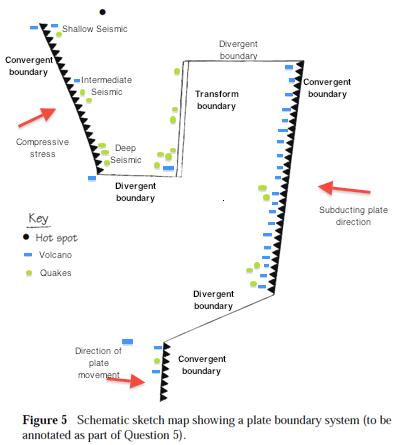1.) Referring directly to the locations of igneous activity identified on the below diagram (figure 5), and restricting yourself to any of the following terms and rocks (sedimentary, igneous, metamorphic, silicates, feldspars, micas, pyroxenes, olivines, basalt, granite, rhyolite, andesite, gabbro, diorite, peridotite, felsic minerals, mafic, intermediate (andesitic) magma, felsic (rhyolitic) magma) compare and contrast the different types of igneous rocks and processes found at each site. Your answer should include information about the source materials and mode of formation (fractional crystallisation, partial melting, dykes, sill, plutons) of the initial magma and the dominant magma compositions present, and whether the magmas are predominantly extrusive or intrusive.

b) Referring directly to the locations of igneous activity you have identified on Figure 5, and restricting yourself to any of the following terms and rocks (sedimentary, igneous, metamorphic, silicates, feldspars, micas, pyroxenes, olivines, basalt, granite, rhyolite, andesite, gabbro, diorite, peridotite, felsic minerals, mafic, intermediate (andesitic) magma, felsic (rhyolitic) magma) compare and contrast the different types of igneous rocks and processes found at each site. Your answer should include information about the source materials and mode of formation (fractional crystallisation, partial melting, dykes, sill, plutons) of the initial magma and the dominant magma compositions present, and whether the magmas are predominantly extrusive or intrusive.